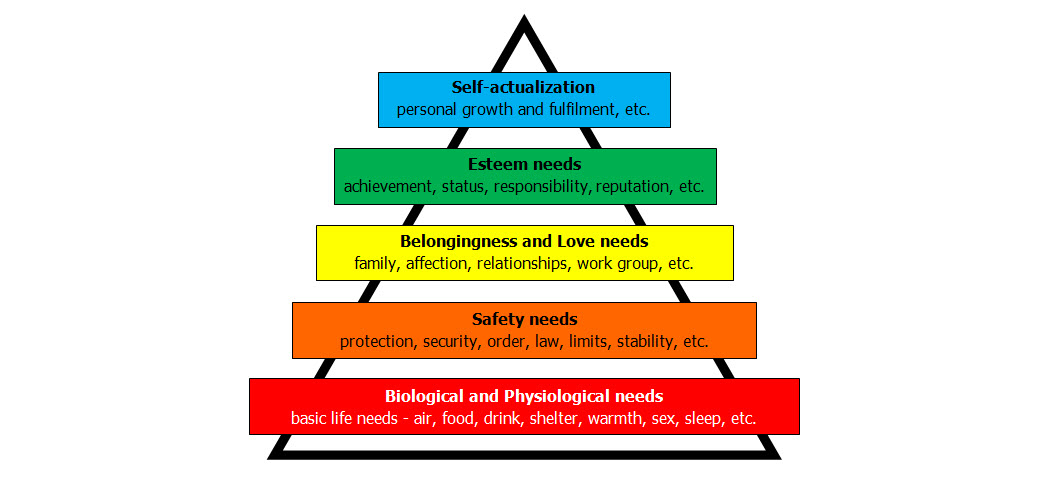Can You Predict the Performance of Your Software Team?

Disclaimer
I'm not a psychologist. I consider myself an armchair psychology practitioner (as if there really is such a thing!) who has a passing interest in the practical application of psychological concepts. If this offends you, do not read further! The rest of this article will consist of me making broad generalizations about a topic that I know (almost) nothing about.
What is Maslow's Needs Hierarchy?
If you know what it is, I don't need to bore you. If you don't, I'm not interested in trying to explain it, as I don't know that much about it either. If you are totally clueless, check out this professional explanation brought to you by the very knowledgeable Wikipedi. Apparently, there's also such a thing as Maslow's Expanded Hierarchy of Needs. However, I don't plan to explore that during this article. If you'd like to learn a bit more about that topic, you can check out this link. In this article, I intent to explore the application of Maslow's Needs Hierarchy and how it can be applied to improve the overall performance of your software team.
Team Performance Correlation Hypothesis
The basic premise of my argument is the following. The more needs that an organization can fulfill for employees from Maslow's Needs Hierarchy, the better the performance of that employee (and the team they are on). Phrased another way, organizations should strive to fulfill employee needs on every level of the needs hierarchy. That does not mean that they should attempt to fulfill every need (in some cases that would be incredibly inappropriate). However, the ability to fill some of their employee's higher-order needs will cause those employees to be more engaged, productive, happy, and loyal.
Biological and Physiological
The minimal needs an organization must provide to hire employees. By paying a wage to an employee, the employer enables them to provide food and shelter for themselves and their family. While not the best way to motivate employees, there are organizations that have built business models around providing the minimum basic needs to employees.
Associated Performance
In exchange for this opportunity, the employee will expend the the minimal level of effort required to stay employed (at least until they find an organization/team/position that is more attractive). Their performance will tend to be inconsistent, as they are continually seeking to do the least amount possible without getting fired.
Safety
At this level, an organization provides an employee stability and security. While they may not like their job, employees are often willing to stay in the position because they 'know what they have', and they are unwilling to trade the status quo for something unknown. It's an environment that is generally predictable, which allows the employee a means of comfortably navigating the organization and the duties required by their particular role.
Associated Performance
Employees in this type of environment provide a steady output of production. While not necessarily looking to go beyond the required output, they generally produce consistent results. These employees are not typically highly-motivated, and often view their employment as 'just a job'.
Belongingness and Love
Organizations looking to maintain any semblance of employee loyalty need to reach this level. Here, employees feel like they belong to the organization. It's more than just a place to trade time for money. They have friends at work (which happens to be a significant factor in employee engagement and happiness), they feel like they are doing work that has a purpose, and they associate with the organizational mission. At this level, it's become more than just a place to work, it's a lifestyle.
Associated Performance
Employees will begin to show flashes of their true potential. They will often go above-and-beyond the requirements of their position to make sure they fulfill their obligations to their team. Since their coworkers are often their friends, they don't want to let them down. They associate with the organizational mission, and contributing to it is rewarding. Employees tend to exhibit consistently good performance, with occasional flashes of brilliance.
Esteem
Building esteem requires that organizations recognize achievements at individual, team, department, and organizational levels. They are very clear at setting objectives, and making sure each employee understands how their work specifically relates to the corporate mission. Responsibilities are clearly outlined, and employees feel obligated to complete work and take great pride in delivering on their objectives.
Associated Performance
Organizations that build esteem consistently get high levels of performance from employees. Employees embrace responsibility, and take initiative to improve their skills and competencies. They express their pride in being associated with their organization. The frequent recognition that is passed out has condition each employee to perform well. Engagement is high, as accomplishments rarely go unnoticed. Employees will often go beyond the call-of-duty to accomplish objectives that they see as necessary or relevant.
Self-Actualization
Only the best organizations are able to consistently fulfill self-actualization needs for a majority of their employees. To do so, an organization must consistently focus on the growth and development of all its employees. While many organizations pay lip-service to this concept, those that 'put their money where their mouth is' are easily spotted.
Associated Performance
These organizations see extremely high levels of employee engagement and satisfaction. Employees are constantly striving to better themselves and their coworkers. Managers are consistently developing their team members skills, talents, and responsibilities. Managers don't feel threatened by high-performing team members, but rather groom them to take on new responsibilities. Employees socialize knowledge and help others grow, rather than hoarding knowledge as a means of job security. Often, employees in these types of organizations have scaled their knowledge in ways that have caused them to become industry experts and thought-leaders. They encourage employees to pursue their passions, even when it means leaving the organization to do so. While, this may seem counter-intuitive, this behavior improves employee loyalty rather than reducing it.
Summary
If you want to make sure your team is performing at the highest level possible, you need to make sure you provide an environment that fulfills more than just your employee's basic needs. The ability to fulfill multiple higher-order needs creates an environment of trust, loyalty, and pride. Employees feel empowered and obligated to maximize their performance both as a means of self-actualization and a sense of responsibility and obligation.







